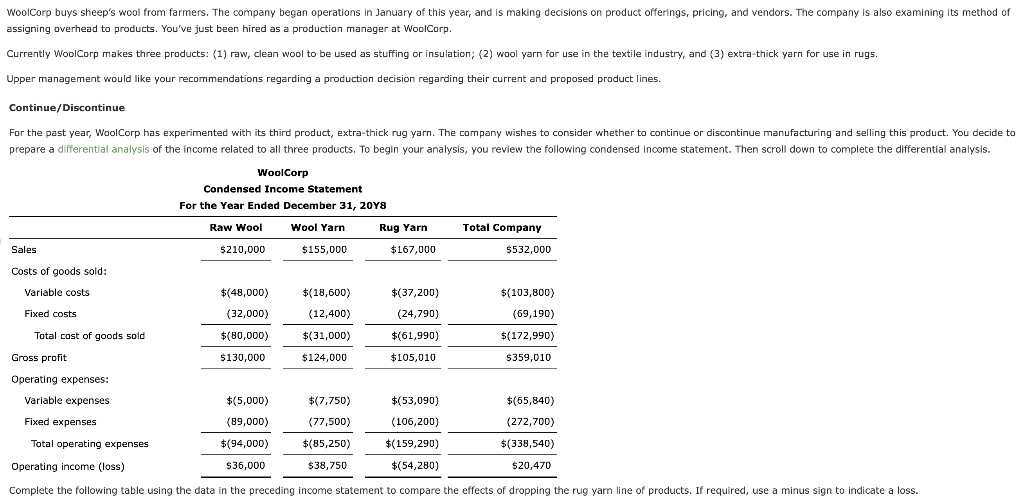WoolCorp buys sheep's wool from farmers. The company began operations in January of this year, and is making decisions on product offerings, pricing, and vendors. The company is also examining its method of assigning overhead to products. You've just been hired as a production manager at WoolCorp. Currently WoolCorp makes three products: (1) raw, clean wool to be used as stuffing or insulation; (2) wool yarn for use in the textile industry, and (3) extra-thick yarn for use in rugs. Upper management would like your recommendations regarding a production decision regarding their current and proposed product lines. Continue/Discontinue. For the past year, WoolCorp has experimented with its third product, extra-thick rug yarn. The company wishes to consider whether to continue or discontinue manufacturing and selling this product. You decide to prepare a differential analysis of the income related to all three products. To begin your analysis, you review the following condensed income statement. Then scroll down to complete the differential analysis. WoolCorp Condensed Income Statement For the Year Ended December 31, 2018 Wool Yarn $155,000 Sales Costs of goods sold: Variable costs Fixed costs Total cost of goods sold Gross profit Operating expenses: Variable expenses. Fixed expenses Total operating expenses Raw Wool $210,000 $(48,000) (32,000) $(80,000) $130,000 $(5,000) (89,000) $(94,000) $36,000 $(18,600) (12,400) $(31,000) $124,000 $(7,750) (77,500) $(85,250) $38,750 Rug Yarn $167,000 $(37,200) (24,790) $(61,990) $105,010 $(53,090) (106,200) $(159,290) $(54,280) Total Company $532,000 $(103,800) (69,190) $(172,990) $359,010 $(65,840) (272,700) $(338,540) $20,470 Operating income (loss) Complete the following table using the data in the preceding income statement to compare the effects of dropping the rug yarn line of products. If required, use a minus sign to indicate a loss.
Master Budget
A master budget can be defined as an estimation of the revenue earned or expenses incurred over a specified period of time in the future and it is generally prepared on a periodic basis which can be either monthly, quarterly, half-yearly, or annually. It helps a business, an organization, or even an individual to manage the money effectively. A budget also helps in monitoring the performance of the people in the organization and helps in better decision-making.
Sales Budget and Selling
A budget is a financial plan designed by an undertaking for a definite period in future which acts as a major contributor towards enhancing the financial success of the business undertaking. The budget generally takes into account both current and future income and expenses.


Step by step
Solved in 3 steps with 3 images








